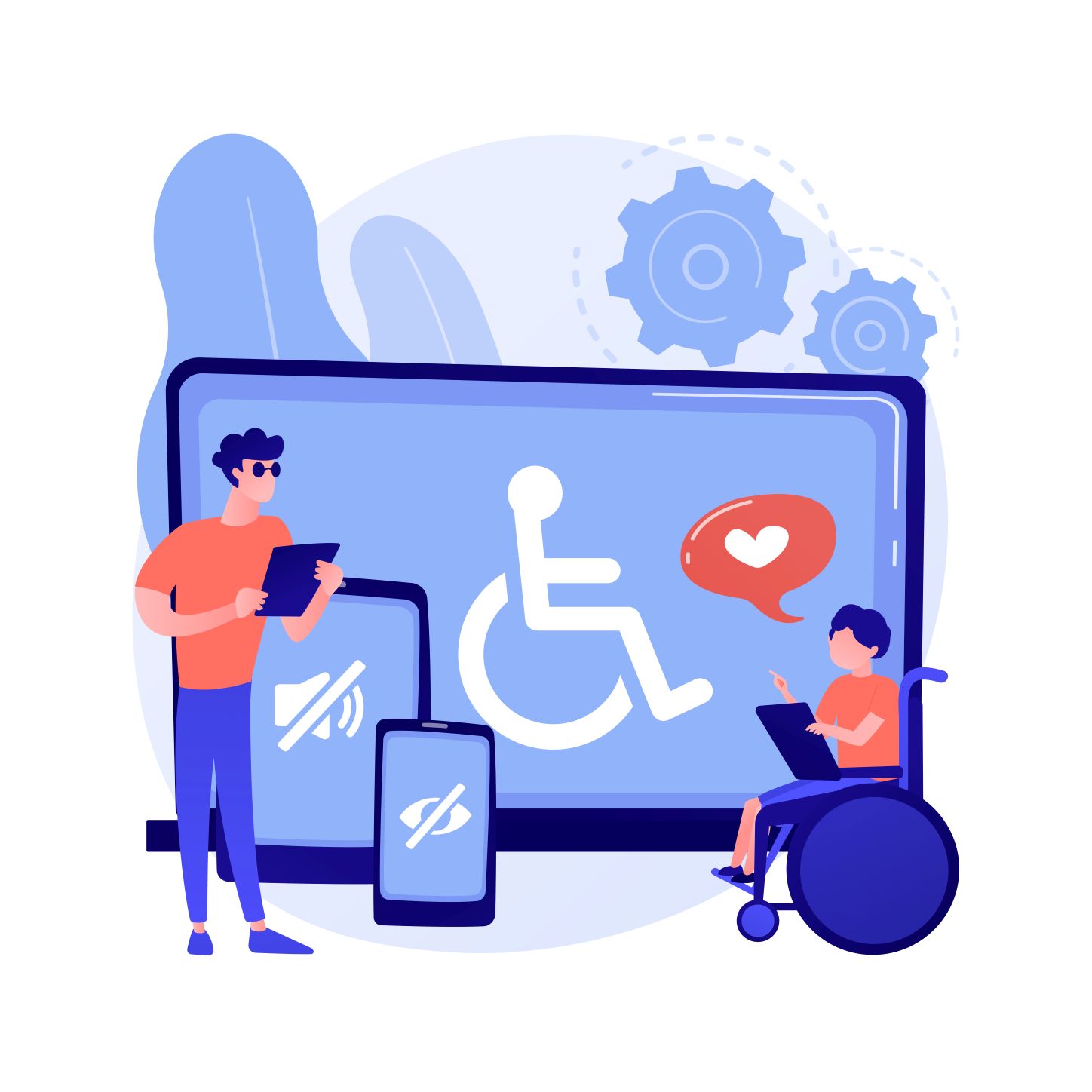 Accessibility is an important topic for any website owner or web user with a disability. While you may be familiar with the Americans with Disabilities Act, the ADA, and its impact on workplace discrimination and increased accommodations, you may be less familiar with current implications on the web.
Accessibility is an important topic for any website owner or web user with a disability. While you may be familiar with the Americans with Disabilities Act, the ADA, and its impact on workplace discrimination and increased accommodations, you may be less familiar with current implications on the web.
What is Accessibility?
Broadly speaking, accessibility encompasses a range of assistive devices, tools, practices, and strategies that accommodate individuals with disabilities.
What is the ADA?
The Americans with Disabilities Act of 1990 is a civil rights law that seeks to prohibit discrimination on the basis of disability.
You may already be familiar with some of the effects of the ADA. For example, the ADA prohibits prospective employers from discriminating against individuals with disabilities, ensures that public spaces are wheelchair accessible, and grants service animals access to public spaces.
Websites and the ADA
When it comes to websites, the ADA does not provide explicit technical specifications that ensure accessibility. However, the ADA does provide a broad understanding that, as public spaces, websites must provide full and equal access to all visitors.
The gold standard for technical specifications that help ensure full and equal access is the World Wide Web Consortium’s Web Content Accessibility Guidelines.
The World Wide Web Consortium is the leading international standards organization for the web and web technologies. The Web Content Accessibility Guidelines have several different versions including 2.0, 2.1, and the forthcoming 2.2. It is best practice to conform to the most recent version of guidelines.
It is also important to note that while the ADA alone does not explicitly include website accessibility, it is increasingly applied to websites in case law. Additionally, some states have or are considering their own rules and regulations regarding website accessibility. Most notably California’s Consumer Privacy Act includes website accessibility requirements and hefty
fines for violations.
What Are The Accessibility Guidelines?
While you may not need to know all of the Web Content Accessibility Guidelines at the drop of a hat, it is nonetheless important to understand the kinds of problems the guidelines address.
For example, if you have ever visited a site that has chosen to use neon yellow text on a bright white background you may understand the importance of color contrast.
For those with color blindness, ensuring recommended color contrast ratios on a website is key to ensuring your content is easily readable.
Individuals with visual impairment may employ a range of assistive technologies to surf the web such as screen readers. Websites and web applications need to be coded in such a way as to allow screen readers to navigate and interact with them.
Similar technologies and practices exist for a range of impairments including auditory and sensory impairments.
Why Should You Care?
Even if you live in a state without explicit website accessibility requirements and penalties for violations, you should still care to put in the extra effort to ensure your site is accessible.
First, while you may not be subject to fines by failing to ensure your website is accessible, you may still be subject to lawsuits. An increasing amount of civil case law supports plaintiffs seeking compensation.
Second, ensuring your website is accessible means more people can visit and use your site successfully which can increase your sales and market share.
Third, helping to ensure everyone is able to access and use your website is a virtuous end in itself.
So now that you understand accessibility on the web let’s take a look at what you can do to evaluate and improve your website.
Beware the Quick Fix
Before taking a deep dive into improving your site let’s take a look at what you don’t want to do.
It should come as no surprise that there are a host of services out there claiming to offer a no-hassle and rapid solution to bringing a website up to accessibility guidelines. Many of these services claim to use advanced technologies such as AI to scan, evaluate, and implement accessibility practices.
Unfortunately, there is currently no way to ensure a site meets all the web content accessibility guidelines without a human conducted site audit and guideline implementation. If you consider the sheer amount of screen sizes, backlighting technologies, touch interfaces, etc. then you begin to understand why there is no single accessibility solution and why a human lead accessibility strategy cannot be replaced by an automated service. For the foreseeable future it will be important to have a website screened and improved by human beings.
First Steps First
Before you start making changes to your website you will want to do a thorough evaluation of your site’s current accessibility. You may find that there are fewer changes than you might think to bring your site up to snuff.
It isn’t always easy to tell just by looking whether your site is accessible. Some features such as color contrast may be visually apparent but many features are buried within the code used to build your website.
Plan and Implement Your Changes
Once you have a clear idea of your site’s strengths and weaknesses you will want to start planning any necessary changes. Be sure you have a clear schedule and timeline for implementing changes. You would for example not want to make key changes during prime business hours.
Also be sure you have backups of the site and document the changes you make every step of the way. This will help if anything goes wrong or if a new team member is eventually brought on and needs to review your practices.
Maintain Your Site
Once your website has been brought up to the WCA guidelines it is important to keep it that way. Naturally, as technology advances, case law is established, and explicit legal guidelines are developed, you will need to ensure you have a plan in place to maintain your website. Keeping abreast of all of these advancements will help you maintain your site and plan for
the future.
Enter the Web Professional
This is the point where you may find yourself feeling a little overwhelmed. If you had never been aware of web accessibility and ADA compliance before reading this you may feel as though you’ve entered a whole new world of technological considerations. Fortunately for you, web professionals are well versed in accessibility standards and technological
tools, tricks, and practices.
Any web developer worth their salt will be knowledgeable and experienced in implementing accessibility standards for a website or web-based software. If looking at code is at all intimidating or unappealing to you then you may want to consider seeking out a web developer to help with your site.
Further, you may also find that User Experience and User Interface (UX/UI) professionals are similarly capable of evaluating a website and implementing necessary changes.
There are also a lot of free resources available to learn more about reviewing and improving your website from the perspective of accessibility.
Here at Mondo we have web professionals that are well versed in web accessibility guidelines, tools, and practices. We would be very happy to review your website and help you to implement a web accessibility strategy if needed.
TL:DR
- Since the ADA, Americans with Disabilities Act, is increasingly interpreted in favor of plaintiff claims and some states have laws requiring website accessibility it is wise to ensure your website is accessible.
- The gold standard for ensuring website accessibility is to implement the W3C’s Web Content Accessibility Guidelines. Use the most recent version of the guidelines.
- Conduct a thorough site audit to identify areas for improvement.
- Develop a plan to implement changes and keep up with new accessibility practices, technologies, and guidelines.
- Seek out the help of a web professional if you need help understanding and implementing web accessibility guidelines.
Helpful Resources
- Web Content Accessibility Guidelines 2.2 Working Draft (forthcoming Mid-2021): https://www.w3.org/TR/WCAG22/
- W3C Information on Web Accessibility: https://www.w3.org/WAI/fundamentals/accessibility-intro/
- Information on Accessibility from usability.gov: https://www.usability.gov/what-and-why/accessibility.html
About Mondo
Mondo is an all-inclusive web, technology, print, and digital marketing agency that leverages it’s in-house equipment and talented industry professionals to provide an alternative to typically expensive marketing services for medium and small businesses. Learn more at trymondo.com.


0 Comments